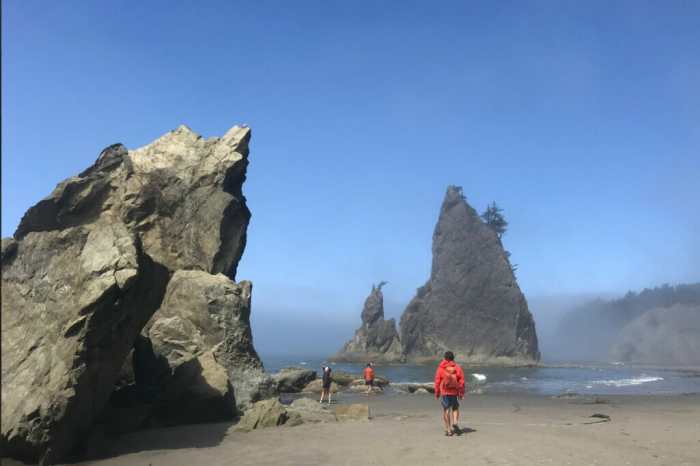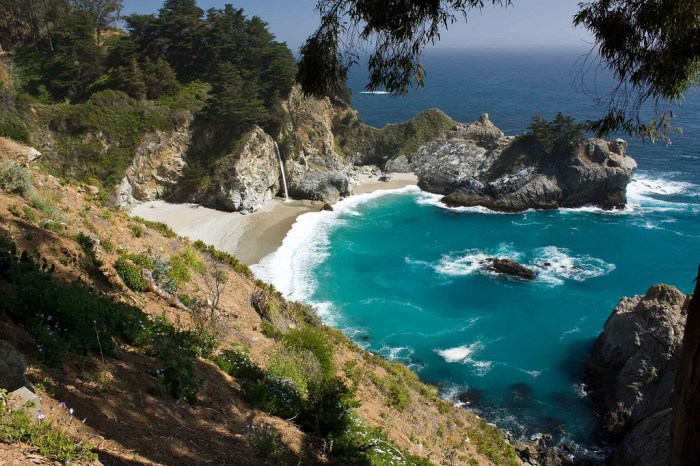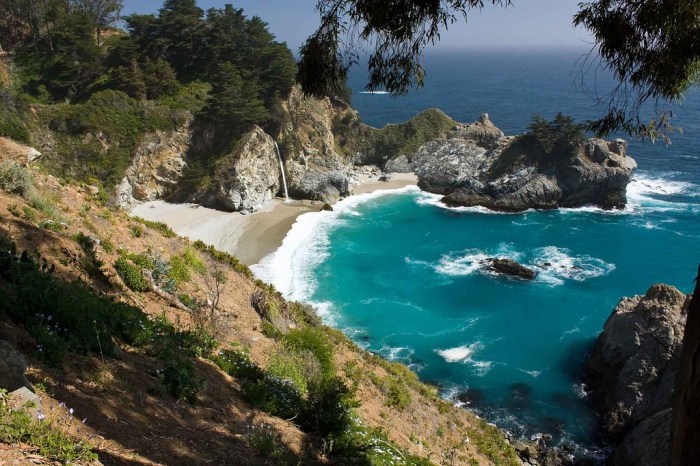Guide to Olympic National Park: Prepare for breathtaking landscapes, thrilling adventures, and unforgettable wildlife encounters in this comprehensive guide. From the towering rainforests to the rugged coastline, Olympic National Park offers something for every outdoor enthusiast. We’ll delve into hiking trails, wildlife viewing opportunities, coastal adventures, and much more, ensuring you’re well-equipped to plan your perfect trip.
This guide will provide a detailed overview of the park’s various ecosystems, highlighting the best hiking trails, wildlife hotspots, and coastal activities. We’ll also cover lodging options, photography tips, outdoor activities, and the park’s climate and weather patterns. Learn about park rules and regulations, accessibility features, and how to plan an unforgettable trip to this stunning natural wonder.
Introduction to Olympic National Park
Olympic National Park, a breathtaking expanse of wilderness on the Olympic Peninsula of Washington State, is a testament to the power and beauty of nature. Spanning diverse ecosystems from lush rainforests to rugged coastlines and towering mountains, the park offers a unique and unforgettable experience for visitors. It’s a place where ancient forests meet the powerful Pacific Ocean, creating a symphony of natural wonders.The park’s history is intertwined with the rich cultural heritage of the Quileute, Hoh, and other indigenous peoples who have called this land home for generations.
It became a national park to preserve this exceptional environment for future generations, safeguarding its remarkable biodiversity and scenic landscapes.
Key Features and Attractions, Guide to olympic national park
Olympic National Park boasts a remarkable array of attractions. From the towering Hoh Rainforest, known for its ancient trees and abundant wildlife, to the dramatic coastline with its dramatic sea stacks and tide pools, the park offers something for every visitor. The rugged mountain peaks, perfect for hiking and exploring, provide stunning views of the surrounding landscape. The park also offers a variety of recreational activities, including fishing, camping, and wildlife viewing.
Park Ecosystems
The park’s varied topography creates a fascinating array of ecosystems. The lush Hoh Rainforest, characterized by its dense canopy and abundant moisture, supports a unique flora and fauna. The rugged coastal areas, marked by powerful waves and dramatic cliffs, harbor a rich marine life. The high-elevation mountain ranges, offering challenging trails and panoramic views, form a stark contrast to the surrounding ecosystems.
Visitor Centers and Facilities
Olympic National Park provides several visitor centers and facilities to enhance the visitor experience. These centers offer information about the park’s history, ecology, and attractions. The park also has a range of facilities, including campgrounds, picnic areas, and restrooms, allowing visitors to explore and enjoy the park comfortably. These facilities are strategically placed to cater to the needs of visitors, ensuring an enjoyable and informative experience.
Park Overview
| Park Name | Location | Established Date | Brief Description |
|---|---|---|---|
| Olympic National Park | Olympic Peninsula, Washington State | August 29, 1938 | A vast wilderness encompassing diverse ecosystems, including rainforests, coastlines, and mountains. Known for its natural beauty and rich biodiversity. |
Hiking and Trails
Olympic National Park boasts a diverse network of hiking trails, catering to hikers of all levels and interests. From gentle strolls along pristine streams to challenging climbs to alpine peaks, the park offers an unforgettable hiking experience. The varied terrain and ecosystems provide a dynamic landscape for every adventure. Understanding the different trails and their characteristics is crucial for a safe and enjoyable experience.
Popular Hiking Trails
The park offers a wide array of trails, ranging from short, easy walks to strenuous multi-day treks. The best trails for you will depend on your fitness level and desired experience. This section highlights some popular trails, categorized by difficulty and length.
Trails by Difficulty and Length
- Easy Trails (under 5 miles): These trails are perfect for families and those seeking a gentle introduction to the park’s beauty. Examples include the short but scenic trails along Lake Quinault or the accessible trails near the Hoh Rainforest. These trails are often well-maintained and offer stunning views of the park’s diverse flora and fauna.
- Moderate Trails (5-10 miles): These trails provide a good balance of challenge and reward. They typically involve some elevation gain and may traverse through varied terrain. A good example of a moderate trail is the Hurricane Ridge Trail, which provides breathtaking views of the Olympic Mountains.
- Strenuous Trails (over 10 miles): These trails demand a higher level of fitness and experience. They often involve significant elevation gain, challenging terrain, and potential exposure to the elements. The Skyline Trail, traversing the Olympic Mountains, is an example of a strenuous trail.
Types of Landscapes Encountered
Hikers in Olympic National Park will encounter a wide array of landscapes. The park’s diverse ecosystems include lush rainforests, alpine meadows, rugged coastlines, and towering mountains. The shifting terrain provides a dynamic experience, with each section offering unique features. For instance, trails through the Hoh Rainforest showcase towering trees and dense vegetation, while trails near the coast reveal the dramatic beauty of the Pacific Ocean.
Comparison of Trails for Different Hikers
The best trails for different types of hikers vary significantly. Families with young children will find the easier trails along lakes or rivers ideal. Experienced hikers seeking a challenge will find the longer, more strenuous trails to be more rewarding. Consider your physical capabilities, desired experience, and the time you have available when selecting a trail. This allows for a safe and fulfilling hiking adventure.
Trail Information Table
| Trail Name | Length (miles) | Difficulty | Notable Features |
|---|---|---|---|
| Lake Quinault Trail | 2 | Easy | Scenic lake views, easy access |
| Hurricane Ridge Trail | 8 | Moderate | Panoramic mountain vistas, moderate elevation gain |
| Skyline Trail | 15 | Strenuous | Olympic Mountain views, challenging terrain |
Trail Maps and GPS Coordinates
Accurate trail maps and GPS coordinates are essential for safe navigation within Olympic National Park. Several resources provide detailed maps and location data, which can be consulted before embarking on any hike. Always double-check the accuracy of the information and be prepared for unexpected changes in weather conditions. Downloading maps and GPS coordinates offline is also recommended, in case of limited or no cell service.
| Trail Name | Trail Map Link | GPS Coordinates |
|---|---|---|
| Lake Quinault Trail | [Insert link to map] | [Insert GPS coordinates] |
| Hurricane Ridge Trail | [Insert link to map] | [Insert GPS coordinates] |
| Skyline Trail | [Insert link to map] | [Insert GPS coordinates] |
Wildlife Viewing
Olympic National Park is a haven for wildlife enthusiasts. From the towering old-growth forests to the rugged coastline, diverse habitats support a remarkable array of creatures. Spotting these animals requires patience, respect for their space, and an understanding of their behaviors. This section will highlight the park’s diverse wildlife, the best places to observe them, and essential etiquette for respectful viewing.The park’s varied ecosystems, ranging from lush rainforests to dramatic coastal cliffs, harbor a wealth of species.
Observing these animals in their natural surroundings offers a unique and enriching experience, fostering a deeper appreciation for the park’s ecological integrity.
Animal Diversity in Olympic National Park
The park’s diverse ecosystems support a rich tapestry of animal life. From the smallest insects to the largest mammals, each species plays a vital role in the park’s delicate balance. Understanding the different species and their habitats enhances your appreciation for the park’s biodiversity.
Best Places to Spot Different Species
Various locations within the park offer excellent opportunities to spot specific animals. The best approach is to research the animals you’re interested in and their preferred habitats. For example, the Quinault Rain Forest is an ideal place to look for deer and elk, while the coastline provides opportunities to see various bird species.
Wildlife Viewing Etiquette
Respect for wildlife is paramount in Olympic National Park. Maintaining a safe distance from animals is crucial to prevent disturbance and allow them to thrive in their natural environment. Never feed animals, as this can alter their natural behaviors and may lead to health problems. Approaching animals cautiously and quietly ensures that their natural behaviors aren’t disrupted, and you maintain a safe distance.
Wildlife by Ecosystem
Olympic National Park’s distinct ecosystems harbor unique wildlife.
- Coastal Ecosystems: The park’s coastline, characterized by rocky shores and beaches, provides habitat for various bird species, including seabirds, shorebirds, and waterfowl. Orcas, gray whales, and seals are occasionally spotted during their migratory journeys. The diverse flora and fauna are perfectly adapted to the constant wind and spray of the Pacific Ocean.
- Rainforest Ecosystems: The old-growth forests are home to a wide variety of mammals, including black bears, Roosevelt elk, deer, and various species of squirrels and chipmunks. The abundant vegetation provides cover for smaller animals and the constant moisture is perfect for supporting a diverse range of amphibians and reptiles.
- Mountain Ecosystems: Higher elevations in the park offer habitat for mountain goats, and birds of prey. The rugged terrain and cooler temperatures create a distinct ecosystem that is home to animals adapted to these challenging conditions.
Wildlife Spotting Guide
This table provides a snapshot of some of the common wildlife you might encounter in Olympic National Park.
| Animal Type | Location to Spot | Key Characteristics |
|---|---|---|
| Black Bear | Quinault Rainforest, and other forested areas | Large, strong body; omnivorous diet; wary of humans |
| Elk | High-elevation meadows and forests | Large, reddish-brown body; herbivores; can be seen in herds |
| Roosevelt Elk | Quinault Rain Forest and other forested areas | Large, reddish-brown body; herbivores; can be seen in herds |
| Osprey | Coastal areas, near water | Large, powerful birds of prey; fish-eaters; often seen perched on prominent locations |
| Gray Whale | Coastal waters (seasonal) | Large marine mammal; migrates; often seen during their migration |
Coastal Adventures
Olympic National Park’s rugged coastline offers a breathtaking spectacle of towering cliffs, pristine beaches, and powerful ocean waves. This dramatic landscape provides unparalleled opportunities for exploration and adventure, from thrilling kayaking trips to peaceful tide pool discoveries. Embrace the raw beauty and unique challenges of the Pacific Northwest’s wild shores.The park’s coastline is a dynamic ecosystem teeming with marine life.
Kayaking, surfing, and tide pooling offer intimate encounters with this vibrant environment. However, it’s crucial to approach these activities with respect for the natural world and awareness of potential hazards. Understanding the specific conditions and following safety guidelines is paramount to enjoying the experience safely and sustainably.
Beaches and Coastal Features
Olympic National Park boasts a diverse range of beaches, from the wide, sandy stretches of Rialto Beach to the rocky coves and tide pools along the rugged coastline. These varied landscapes offer unique perspectives on the park’s dramatic beauty and the power of the Pacific Ocean. The constant interplay of waves, currents, and tides shapes the shoreline, creating a constantly evolving environment.
Kayaking and Paddleboarding
Kayaking and paddleboarding are excellent ways to explore the coastline at a slower pace. The park’s sheltered bays and inlets provide calm waters for beginners, while exposed sections offer thrilling challenges for experienced paddlers. Be mindful of currents, tides, and potential hazards like strong winds. Always check weather forecasts and tide charts before embarking on any water-based activity.
Surfing
The park’s surf breaks are legendary, attracting experienced surfers from around the world. However, the unpredictable nature of ocean waves demands respect and caution. Conditions can change rapidly, and powerful currents can pose serious risks. Seek advice from local surf shops or experienced surfers about the best spots and safety precautions. Remember to assess conditions carefully before entering the water.
Tide Pooling
Exploring tide pools is a rewarding way to discover the fascinating world of marine invertebrates. These intertidal zones are filled with diverse creatures, from anemones and crabs to starfish and sea urchins. However, tide pooling requires understanding of the tides and potential hazards. Always wear sturdy shoes and be mindful of slippery rocks. Be careful not to disturb the delicate balance of the ecosystem.
Avoid touching or removing any organisms.
Coastal Hazards and Safety Precautions
The Pacific Ocean’s power must always be respected. Coastal hazards, such as strong currents, unpredictable waves, and sudden changes in weather, are significant factors. Always check the weather forecast and tide charts before heading out. Carry appropriate safety equipment, including a whistle, a buoyant device, and a cell phone with a charged battery. Inform someone of your plans and expected return time.
Respecting the Marine Environment
The marine environment in Olympic National Park is a fragile ecosystem. Responsible actions are essential to ensure its continued health. Leave no trace; pack out everything you pack in. Avoid disturbing wildlife or marine life. Do not touch or remove any marine organisms.
Support responsible tourism practices.
| Activity Type | Location | Necessary Precautions |
|---|---|---|
| Kayaking | Sheltered bays and inlets | Check weather, tides, and currents; wear appropriate safety gear |
| Surfing | Designated surf breaks | Assess conditions carefully; heed advice from locals; wear appropriate safety gear |
| Tide Pooling | Intertidal zones | Be mindful of tides and slippery rocks; avoid touching or removing organisms; wear appropriate footwear |
Lodging and Amenities
Olympic National Park offers a diverse range of lodging options to suit various budgets and preferences, from rustic camping experiences to comfortable cabins and hotels. Whether you’re seeking a budget-friendly adventure or a more luxurious stay, the park provides accommodations that complement the natural beauty and diverse landscapes. Finding the perfect place to rest your head is just as important as exploring the trails and wildlife.
Camping Options
Camping within the park provides a truly immersive experience, allowing you to connect with nature firsthand. Various campsites are available, catering to different needs and preferences. Reservations are highly recommended, especially during peak season.
- Backcountry Camping: For the most secluded experience, backcountry camping requires permits and involves hiking to designated sites. This option demands careful planning and preparation, including necessary gear and supplies. It’s an excellent choice for experienced backpackers.
- Developed Campgrounds: Developed campgrounds offer amenities like restrooms, water, and picnic tables. These provide a more convenient and comfortable experience compared to backcountry camping. Reservations are crucial to secure a spot.
- Reservations and Fees: Reservations for all camping sites are essential and can be made through Recreation.gov or the Olympic National Park website. Fees vary depending on the campground and site type. Be prepared to pay for the campsite and any applicable entrance fees.
Cabins and Cottages
For those seeking a more comfortable stay, cabins and cottages offer a balance between convenience and nature. These options typically include basic amenities like beds, cooking facilities, and restrooms. They are often located in or near developed campgrounds, providing access to park amenities.
- Cabin Amenities: Cabins usually feature basic furnishings, such as beds, tables, and chairs. Cooking facilities may include a stove, refrigerator, and utensils. Restrooms and showers are generally available.
- Location and Accessibility: Cabins are often situated in proximity to trails and viewpoints, providing easy access to park attractions. Some cabins may have limited space, so it’s crucial to check beforehand.
- Reservation Policies: Cabin reservations often follow similar procedures to campsite reservations, requiring advance bookings through the park website or Recreation.gov. Consider booking well in advance, especially during peak seasons.
Hotels and Other Lodging Options
For visitors who prefer hotel-style accommodations, several options exist outside the park boundaries. These hotels often provide more modern amenities and services.
- Nearby Hotels: Several hotels and motels are located within a short drive of Olympic National Park. These offer varying levels of comfort and amenities, from budget-friendly to luxurious options. They provide more convenience and comfort for those who prefer hotel-style lodging.
- Amenities and Services: Hotel amenities often include restaurants, swimming pools, and business centers. This may be a good option if you need access to amenities not found in park lodging.
- Distance and Travel Time: The location of hotels near the park will impact travel time to attractions within the park. Be mindful of potential traffic delays and plan accordingly.
Lodging Comparison Table
| Lodging Type | Cost | Location | Amenities |
|---|---|---|---|
| Developed Campground | Moderate | Within the park | Restrooms, water, picnic tables |
| Cabin | Moderate to High | Within or near the park | Basic kitchen, sleeping accommodations, restrooms |
| Hotel (Near Park) | Variable | Outside the park | Varying, often including pools, restaurants |
Reservations and Booking Procedures
Reservations are essential for most lodging options within or near Olympic National Park. Bookings can be made online through Recreation.gov or the official park website. It is crucial to check availability and make reservations well in advance, especially during peak season. Be sure to check cancellation policies.
Photography Opportunities
Olympic National Park, a breathtaking tapestry of forests, mountains, and coastlines, provides unparalleled photographic opportunities. From the vibrant emerald hues of the Hoh Rainforest to the rugged beauty of the Pacific coastline, the park is a photographer’s dream. Capturing these scenes requires understanding the best times of year and specific camera settings to achieve the desired results.This section will explore the exceptional photographic opportunities in Olympic National Park, detailing ideal times for capturing stunning images, optimal camera settings for various subjects, and iconic viewpoints.
Armed with this knowledge, you’ll be ready to capture unforgettable memories and create stunning photographic masterpieces.
I’m currently deep diving into a guide to Olympic National Park, exploring its stunning forests and rugged coastline. While I’m fascinated by the Pacific Northwest, I’ve also been researching the charming small towns in New Hampshire, like those featured in the best small towns in new Hampshire. It’s inspiring to learn about the diverse beauty of the US and how these seemingly disparate locations offer such unique experiences.
Getting back to the park, I’m excited to plan my trip, and I’ll definitely keep this guide top of mind as I do!
Best Times for Photography
Understanding the best time of year for photography is crucial to capturing the park’s unique beauty. Spring and fall offer vibrant foliage and mild weather, perfect for capturing the park’s changing colors. Summer provides ideal conditions for wildlife photography, with animals often more active. Winter presents a unique challenge and reward, offering dramatic landscapes under snow and ice.
The light and atmospheric conditions during different times of year can dramatically alter the mood and appearance of your photographs.
Camera Settings for Specific Subjects
Choosing the right camera settings is essential for achieving the desired results. For capturing the lush greenery of the rainforest, a wider aperture (e.g., f/2.8 or f/4) and a moderate ISO will allow for a shallow depth of field, isolating the subject while still maintaining a bright image. Wildlife photography necessitates a fast shutter speed to freeze motion and a high ISO to compensate for low light.
My guide to Olympic National Park is all about stunning landscapes and incredible hikes, but sometimes you need a break from the great outdoors. For a taste of urban exploration, check out some fantastic trip ideas like the Frevo Restaurant, nestled inside an art gallery in Greenwich Village trip ideas frevo restaurant inside art gallery greenwich village.
Then, when you’re ready to return to the natural beauty of the park, you can get back to the stunning views and fresh air. It’s all about balance, right?
Coastal photography calls for careful attention to light and waves, sometimes requiring a polarizing filter to reduce glare and enhance color saturation. Consider your subject and lighting conditions to optimize your camera settings for a perfect shot.
Iconic Viewpoints and Locations
Olympic National Park boasts numerous iconic viewpoints. The Hurricane Ridge offers panoramic vistas of the mountains, perfect for capturing expansive landscapes. The Quinault Rain Forest offers unique photographic opportunities, with its dense foliage and misty ambiance. The Ruby Beach coastal area is renowned for its dramatic rock formations and crashing waves. Each location offers a distinct aesthetic and photographic challenge, rewarding photographers with unforgettable experiences.
Suggested Photography Techniques by Location
| Location | Season | Suggested Photography Techniques |
|---|---|---|
| Hurricane Ridge | Spring, Fall | Wide-angle shots of the expansive vista; use a tripod for sharper images; consider the interplay of light and shadow. |
| Quinault Rain Forest | Spring, Summer | Focus on the interplay of light and shadow within the dense foliage; use a neutral density filter to capture the misty atmosphere; try long exposures to emphasize the depth of the forest. |
| Ruby Beach | Spring, Summer | Capture the dramatic rock formations and crashing waves; use a fast shutter speed to freeze the motion of the waves; consider a polarizing filter to reduce glare and enhance colors. |
| Hoh Rainforest | Spring, Summer | Capture the vibrant green hues of the rainforest; use a wide aperture to isolate the subject while maintaining a bright image; consider a shallow depth of field to emphasize the textures. |
Outdoor Activities: Guide To Olympic National Park
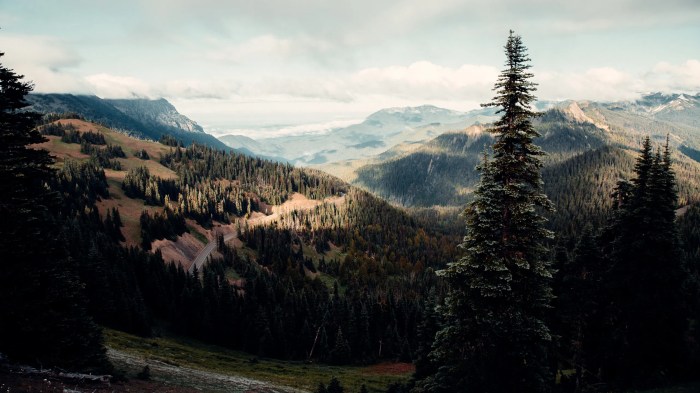
Olympic National Park offers a plethora of exhilarating outdoor activities, from serene fishing expeditions to challenging climbs. Whether you’re an experienced adventurer or a weekend warrior, the park provides opportunities for all skill levels. Understanding the park’s regulations and safety precautions is paramount for a memorable and safe experience.Engaging in these activities requires respect for the environment and fellow visitors.
Proper preparation, including acquiring necessary permits and adhering to park regulations, ensures a positive and responsible experience for everyone. Understanding the specific requirements for each activity, along with potential hazards, is crucial for a safe and enjoyable visit.
Fishing
Fishing in Olympic National Park is a popular pastime. The park’s diverse aquatic ecosystems support a variety of fish species. Different lakes and rivers have varying regulations. To ensure you’re fishing legally, always check the park’s website for updated regulations. Know the specific catch limits and the types of fish allowed to be kept or released.
Also, be mindful of fishing seasons.
Boating
Boating provides a unique perspective of the park’s stunning coastline and inland waterways. Numerous lakes and rivers are accessible by boat, offering opportunities for paddling, kayaking, or canoeing. Always be aware of weather conditions and potential hazards, such as strong currents and hidden rocks. Be sure to obtain any necessary permits or licenses for boating within the park.
Ensure that you are equipped with safety gear like life vests and communication devices for emergencies.
Climbing
Olympic National Park features diverse climbing opportunities, from easy scrambles to challenging rock faces. Before attempting any climb, familiarize yourself with the specific regulations and routes. Ensure you have the necessary gear and experience for the selected climb. Check the park’s regulations for permits required for climbing specific areas. Understand the potential dangers of falls and other hazards, and carry appropriate safety equipment like ropes, harnesses, and helmets.
Be aware of any climbing restrictions in specific areas, and know how to use climbing equipment safely.
Planning a trip to Olympic National Park? Knowing the best time to visit is key for maximizing your adventure. While the park’s beauty shines year-round, spring and fall offer pleasant temperatures and fewer crowds. For a truly immersive experience, consider checking out the best time to visit Prague best time to visit prague as well, and tailoring your Olympic National Park trip accordingly.
This comprehensive guide will help you make the most of your time in the park, whether you’re hiking, camping, or simply soaking in the stunning scenery.
Other Outdoor Activities
Olympic National Park permits a range of other outdoor activities, including backpacking, wildlife viewing, and horseback riding. Consult the park’s official website for comprehensive details on permits, regulations, and safety guidelines. Be prepared for varying conditions, and ensure you have appropriate gear for the specific activity.
Park Rules and Regulations
Olympic National Park has established rules and regulations to ensure visitor safety and environmental protection. These regulations cover everything from campfire restrictions to trail etiquette. It is crucial to be familiar with these rules to maintain a safe and respectful environment for everyone. Be aware of fire restrictions, especially during dry seasons. Never leave a campfire unattended.
Safety Precautions
Safety is paramount when engaging in outdoor activities. Understanding potential hazards and taking necessary precautions is crucial. Always check the weather forecast and dress appropriately for the conditions. Be aware of wildlife, and practice appropriate wildlife viewing etiquette. Bring sufficient water, food, and appropriate clothing for the weather.
| Activity Type | Necessary Equipment | Safety Guidelines |
|---|---|---|
| Fishing | Fishing license, rod, reel, tackle, appropriate footwear | Check regulations, know catch limits, be aware of weather conditions, practice catch and release where applicable. |
| Boating | Boat, life vests, paddles, safety equipment, communication device | Be aware of weather conditions, currents, and potential hazards, obtain permits if required. |
| Climbing | Appropriate climbing gear, ropes, harnesses, helmets, experience and training | Know the route, check regulations, be aware of potential hazards, carry first-aid supplies. |
Climate and Weather
Olympic National Park boasts a remarkable diversity of climates, a reflection of its varied terrain. From the temperate rainforests of the west coast to the high peaks of the mountains, the weather can shift dramatically within short distances. Understanding these variations is crucial for planning a successful trip and maximizing your outdoor adventures.The park’s climate is heavily influenced by its proximity to the Pacific Ocean.
This results in cool, wet conditions along the coast, contrasted with warmer, drier conditions in the higher elevations. Seasonal changes play a significant role in the park’s atmosphere and dictate the best time to visit for specific activities.
Seasonal Variations
The park experiences distinct seasons, each with its own character. Spring brings a burst of life, with wildflowers blooming and the potential for pleasant hiking conditions. Summer offers long days of sunshine, ideal for exploring the coastal trails and enjoying the abundant wildlife. Autumn paints the forests in vibrant hues of red, orange, and gold, creating a breathtaking spectacle.
Winter brings snowfall to the mountains, transforming the landscape into a winter wonderland, but also presents challenges for travel and outdoor activities.
Impact on Outdoor Activities
The changing weather significantly affects the feasibility and enjoyment of various activities. For example, heavy rain can make hiking trails muddy and slippery, potentially affecting safety. Snowfall in the mountains can impact access to trails and require specialized gear. Knowing the anticipated weather conditions for your chosen dates will allow you to prepare adequately and make informed decisions about your itinerary.
Preparing for Different Weather Conditions
A key element to a successful trip is preparation for unpredictable weather. Pack layers of clothing to adapt to temperature fluctuations. Waterproof jackets and pants are essential for rain or snow. Durable hiking boots with good traction are vital for maintaining stability on various terrains, especially when the trails are wet or icy. Don’t forget extra layers, like fleece jackets, warm socks, and hats.
Also, check the forecast for wind conditions, as it can significantly impact the comfort level during outdoor activities.
Best Times to Visit
The best time to visit Olympic National Park is highly dependent on your preferred activities. Spring offers pleasant temperatures and blooming wildflowers, making it ideal for hiking and exploring. Summer provides longer days and warm weather, ideal for coastal adventures and wildlife viewing. Autumn offers a stunning display of fall foliage, perfect for scenic drives and hikes. Winter is best suited for those who enjoy snowshoeing, cross-country skiing, or simply taking in the winter wonderland.
Average Temperatures and Precipitation
| Month | Average High (°C) | Average Low (°C) | Average Precipitation (mm) |
|---|---|---|---|
| January | 6 | 2 | 200 |
| February | 7 | 3 | 180 |
| March | 8 | 4 | 160 |
| April | 10 | 6 | 140 |
| May | 12 | 8 | 120 |
| June | 14 | 10 | 100 |
| July | 16 | 12 | 80 |
| August | 16 | 12 | 80 |
| September | 14 | 10 | 100 |
| October | 12 | 8 | 120 |
| November | 10 | 6 | 140 |
| December | 8 | 4 | 160 |
Note
* These are average values and actual conditions can vary significantly. Always check the most recent weather forecasts before your trip.
Accessibility and Inclusivity
Olympic National Park strives to be a welcoming destination for all visitors, including those with disabilities. The park actively works to ensure that everyone can enjoy the park’s incredible natural beauty and diverse experiences. This commitment to accessibility extends to various aspects of the park, from trail access to lodging facilities.This section highlights the park’s accessibility features and provisions for visitors with diverse needs, outlining accessible trails and facilities, and showcasing the park’s dedication to inclusivity.
Accessible Trails and Facilities
The park offers a range of accessible trails, catering to different mobility levels. These trails are clearly marked and often include paved sections or gentle grades. The park also works diligently to ensure that its facilities, such as visitor centers, restrooms, and picnic areas, are accessible to those using wheelchairs or other mobility devices. Many viewpoints and trailheads feature ramps or elevators for easier access.
This allows for a wider range of experiences and fosters a more inclusive environment.
Accessible Transportation Options
The park provides several transportation options to facilitate access for visitors with mobility limitations. Park buses are often equipped with ramps and accessible seating. Additionally, there are accessible van services available to transport visitors to various destinations within the park. These options ensure convenient and safe travel for visitors with mobility needs, allowing them to fully immerse themselves in the park’s natural wonders.
Accessible Lodging and Amenities
Olympic National Park partners with nearby hotels and lodging establishments to offer accessible accommodations. Many motels and campgrounds have rooms and campsites that are designed for wheelchair users and those with other disabilities. This ensures that visitors with various needs have options to stay within close proximity to the park.
Commitment to Inclusivity
Olympic National Park emphasizes inclusivity as a fundamental aspect of its visitor experience. The park’s commitment to inclusivity extends beyond accessibility, encompassing a broader understanding of diverse needs and experiences. This includes providing clear and concise information about accessible features and services in multiple languages and formats, promoting a sense of belonging and comfort for all visitors.
Table of Accessible Facilities and Transportation Options
| Facility/Transportation | Description |
|---|---|
| Accessible Trails | Marked trails with paved sections, gentle grades, and ramps at trailheads. |
| Park Buses | Equipped with ramps and accessible seating. |
| Accessible Van Services | Transport visitors to various destinations within the park. |
| Accessible Lodging | Partnering with nearby hotels and campgrounds to provide rooms and campsites designed for wheelchair users and others with disabilities. |
| Visitor Centers | Equipped with accessible restrooms, ramps, and elevators. |
| Restrooms | ADA compliant restrooms with grab bars, accessible stalls, and appropriate signage. |
Park Rules and Regulations
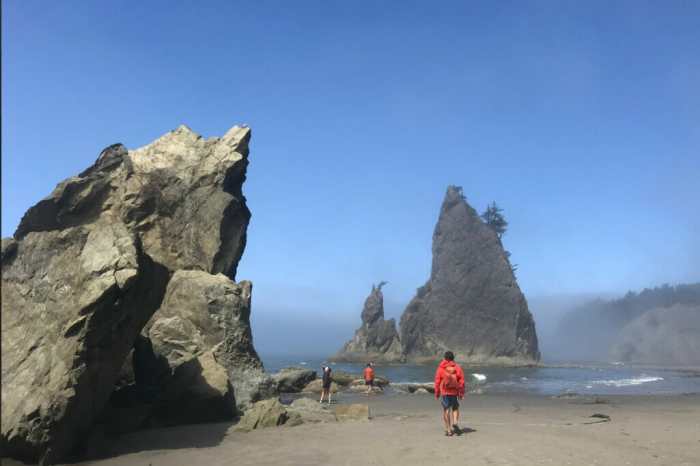
Olympic National Park, a treasure trove of natural beauty, demands respect for its delicate ecosystems and wildlife. Understanding and adhering to the park’s rules and regulations is crucial for ensuring a positive experience for all visitors and preserving the park’s pristine condition for future generations. These rules are designed to protect the environment and the safety of everyone within the park.Respecting the environment and its inhabitants is paramount in Olympic National Park.
This involves minimizing your impact, understanding the fragile balance of the ecosystem, and treating the park’s resources with care. Wildlife should be observed from a safe distance, and their natural behaviors should be appreciated without interference.
Important Considerations for Visitors
This section highlights key aspects of responsible park conduct. Respecting the environment and wildlife is essential for maintaining the park’s integrity and ensuring a positive experience for all visitors. Visitors should avoid actions that could harm the environment or disturb wildlife.
- Leave No Trace: This principle is fundamental to responsible park use. Pack out everything you pack in, minimizing your impact on the environment. Dispose of trash properly in designated receptacles and avoid disturbing natural features.
- Wildlife Viewing: Observe wildlife from a safe distance, avoiding any actions that could disturb or threaten them. Do not feed or approach wildlife, as this can disrupt their natural behaviors and may pose risks to both you and the animals.
- Fire Safety: Campfires are permitted in designated fire rings only. Always check fire restrictions and maintain a safe distance from the fire at all times. Ensure the fire is completely extinguished before leaving the area.
Camping Regulations
Proper camping etiquette is essential for maintaining the peace and quiet of the park.
- Campsite Reservations: Reservations are highly recommended, especially during peak season, and must be made in advance. Ensure you understand the regulations pertaining to specific campgrounds within the park, such as site size and amenities available.
- Campground Cleanliness: Campers are expected to maintain the cleanliness of their campsites and leave them in the same condition they found them. Properly dispose of all trash and maintain a respectful distance from neighboring campsites.
- Campfire Restrictions: Be aware of and adhere to all fire restrictions in effect at the time of your visit. These restrictions can change based on weather conditions and other factors. Always check with park rangers for current regulations.
Hiking and Trail Regulations
Hiking trails are integral to the park’s experience, but adherence to specific regulations is crucial for maintaining trail integrity.
- Trail Etiquette: Stay on designated trails to prevent erosion and damage to the natural environment. Avoid disturbing vegetation and wildlife along the trails.
- Leave No Trace: Pack out all trash and waste, minimizing your impact on the environment. Be mindful of your presence and avoid actions that could damage the trails.
- Wildlife Encounters: If encountering wildlife, maintain a safe distance and observe their natural behaviors without disturbing them. Carry bear spray, and be aware of potential risks.
Penalties for Violations
Violation of park regulations can result in penalties, ranging from warnings to fines.
- Severity of Penalties: Penalties for violating park regulations can vary depending on the severity of the violation. Repeat offenses or significant violations can result in more severe consequences.
- Specific Fines: Specific fines for violations can be found in the official park regulations. These regulations may specify different fines for various violations.
- Enforcement Procedures: Park rangers are responsible for enforcing park regulations and may issue warnings or citations to violators.
Table of Park Rules and Penalties
| Rule | Penalty |
|---|---|
| Littering | Warning or fine |
| Feeding wildlife | Warning or fine, possible removal from the park |
| Illegal camping | Warning or fine, removal from the park |
| Damaging trails | Warning or fine, removal from the park |
| Starting a fire without permission | Warning or fine, possible removal from the park |
Outcome Summary
In conclusion, Olympic National Park is a treasure trove of natural beauty and adventure. This guide has provided a comprehensive overview of the park’s highlights, offering insights into its diverse ecosystems, activities, and amenities. Whether you’re an experienced hiker, a wildlife enthusiast, or a coastal adventurer, this guide equips you with the knowledge to create an unforgettable experience within this remarkable national park.
Now get out there and explore!
